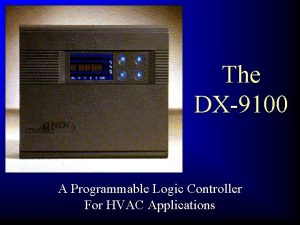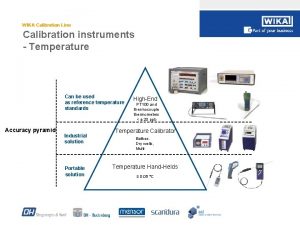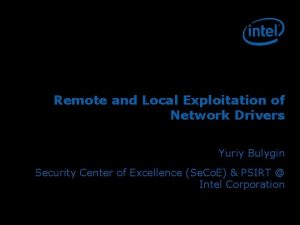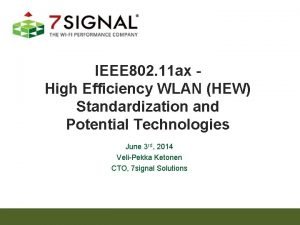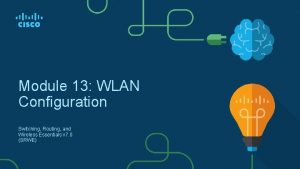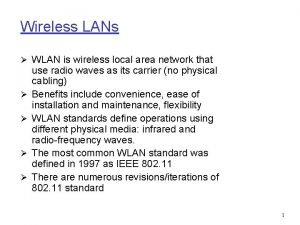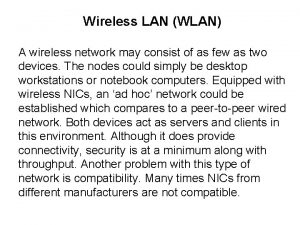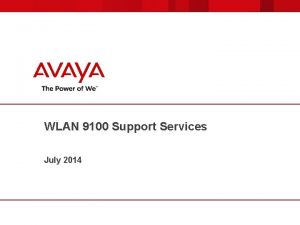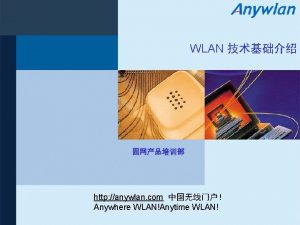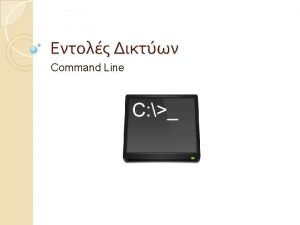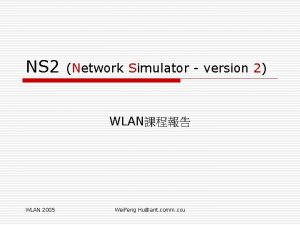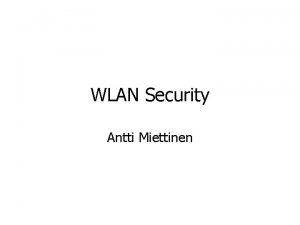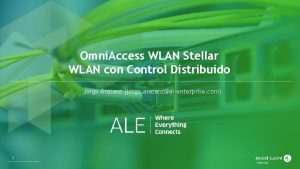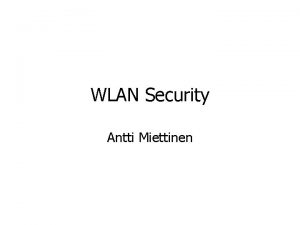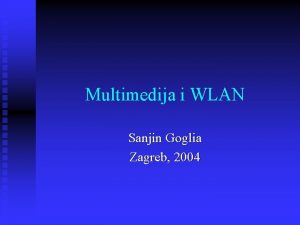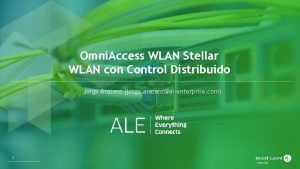WLAN 9100 Deep Dive April 2014 AGENDA 4



































- Slides: 35

WLAN 9100 Deep Dive April 2014

AGENDA 4 WLAN architecture review 4 WLAN 9100 portfolio overview 4 802. 11 ac new standard 4 WLAN 9100 features 4 WOS – Centralized Management Solution 4 Orderable parts and licensing 4 Q&A ** Cloud management phase 2 © 2014 Avaya Inc. Avaya – Confidential & Proprietary Do not duplicate, publish or distribute further without the express written permission of Avaya.

Wi Fi Architectures and Traffic Flow Centralized Traffic Management Edge Traffic Management SPo. F Central Control • • Central processing creates bottlenecks Single Point of Failures Stair step scalability Intelligence Choke Point © 2014 Avaya Inc. Avaya – Confidential & Proprietary Do not duplicate, publish or distribute further without the express written permission of Avaya. Distributed Control • • Control at edge for best performance No Single Point of Failure Seamless Scalability Distributed Intelligence

Architecture Comparison: Intelligence at the Edge Avaya © 2014 Avaya Inc. Avaya – Confidential & Proprietary Do not duplicate, publish or distribute further without the express written permission of Avaya.

WLAN 9100 Portfolio What do we launch? PHASE 1 (May 2014) PHASE 2 (end 2014) Next-gen wireless with predictable performance ü 802. 11 ac ü Simplified RF planning WAP 9122 WAP 9123 WAP 9132 WAP 9133 WAO 9122 (Outdoor) WAP 9162/9173 802. 11 n 2 x 2 AP 802. 11 n 3 x 3 AP 802. 11 ac 2 x 2 AP 802. 11 ac 3 x 3 AP 802. 11 n 2 x 2 AP 802. 11 ac 2 x 2 / 3 x 3 2 Radios 2 Radios 2 or 4 Radios Common Advanced Feature Set Integrated Controller Application Control Zero Touch Provisioning ü Application Qo. S control ü Wlan architecture with distributed controller ü Swap less upgrades ü Cloud based management** ü Single Software stream ü Flexible deployment ü Bonjour support ** phase 2 On Premise or Cloud Management WLAN Distributed Architecture © 2014 Avaya Inc. Avaya – Confidential & Proprietary Do not duplicate, publish or distribute further without the express written permission of Avaya. 5

WAP 9122 & 9123 ACCESS POINTS 4 Indoor dual radio AP with omni directional antennas 4 Models: – WAP 9123: 3 x 3 11 n – WAP 9122: 2 x 2 11 n 4 Software programmable per radio – Dual bands 2. 4 GHz and 5 GHz – Multiple modes 802. 11 a/bg/n – 11 ac software upgradable 4 Integrated controller 4 Integrated services: – Application Control: Visibility and Policy Enforcement – Security: WIDS/WIPS, Firewall, Guest Access – Analytics: Spectrum Analysis, Packet Capture 4 Dual Gigabit Ethernet uplinks 4 802. 3 at POE+ powered (9122 can use POE) 4 Cloud** or on premise provisioning and management ** Cloud management phase 2 © 2014 Avaya Inc. Avaya – Confidential & Proprietary Do not duplicate, publish or distribute further without the express written permission of Avaya.

WAP 9132 & 9133 ACCESS POINTS 4 Dual radio APs with omni directional antennas 4 Models: – WAP 9133: 3 x 3 11 ac – WAP 9132: 2 x 2 11 ac 4 Software programmable radios – Dual bands 2. 4 GHz and 5 GHz – Multiple modes 802. 11 a/bg/n/ac 4 Integrated controller 4 Integrated services: – Application Control: Visibility and Policy Enforcement – Security: WIDS/WIPS, Firewall, Guest Access – Analytics: Spectrum Analysis, Packet Capture 4 Dual Gigabit Ethernet uplinks 4 802. 3 at POE+ powered 4 Cloud** or on premise provisioning and management ** Cloud management phase 2 © 2014 Avaya Inc. Avaya – Confidential & Proprietary Do not duplicate, publish or distribute further without the express written permission of Avaya.

WAO 9122 ACCESS POINT 4 Outdoor dual radio AP with external antennas – External RP TNC antenna connectors two per radio – Directional – Omni 4 Models: – WAO 9122: 2 x 2 11 n 4 Software programmable per radio – Dual bands 2. 4 GHz and 5 GHz – Multiple modes 802. 11 a/bg/n 4 Integrated controller 4 Integrated services: – Application Control: Visibility and Policy Enforcement – Security: WIDS/WIPS, Firewall, Guest Access – Analytics: Spectrum Analysis, Packet Capture 4 Single Gigabit Ethernet uplinks 4 802. 3 af POE powered 4 Cloud** or on premise provisioning and management ** Cloud management phase 2 © 2014 Avaya Inc. Avaya – Confidential & Proprietary Do not duplicate, publish or distribute further without the express written permission of Avaya.

2 X 2 AND 3 X 3 11 AC? 4 What is 2 x 2 and 3 x 3 11 ac? – 2 x 2 = 2 antennas, 2 spatial data streams – 3 x 3 = 3 antennas, 3 spatial data streams – Additional streams provides additional throughput – 2 x 2 = up to 867 Mbps data rates per radio – 3 x 3 = up to 1. 3 Gbps data rates per radio – 11 ac is about 3 X faster than 11 n © 2014 Avaya Inc. Avaya – Confidential & Proprietary Do not duplicate, publish or distribute further without the express written permission of Avaya. Thousands 4 How fast is 2 x 2 and 3 x 3 11 ac? Data Rate Comparison by Wi. Fi Technology 1, 4 1, 2 1 0, 8 0, 6 0, 4 0, 2 0 2 x 2 11 n 3 x 3 11 n 2 x 2 11 ac 3 x 3 11 ac

Remember: Wi fi performance is limited by the device Most BYOD clients are 1 x 1 or 2 x 2 and cannot take advantage of 3 streams in a 3 x 3 Wi Fi infrastructure Device 2. 4 GHz 5 GHz Antennas Max Rate Media Players (i. Pod Touch) X Some 1 x 1 65 150 Mbps Smartphones – low end X 1 x 1 65 Mbps Smartphones – high end X 1 x 1 150 Mbps Tablets – low end X 1 x 1 65 Mbps Tablets – high end (i. Pad) X X 2 x 2 300 Mbps Laptops – low end X Most 2 x 2 300 Mbps Laptops – mid/high end X X 3 x 3 450 Mbps X

DEPLOYING DIFFERENT 11 AC TECHNOLOGIES WITH AVAYA WLAN 9100 4 Where would you use 2 x 2 11 ac vs. 3 x 3 11 ac? – Use 2 x 2 in more cost sensitive areas with low to medium user density – Use 3 x 3 in higher performance areas or where there is more laptop usage 4 What are the key benefits of 2 x 2 11 ac? – Reduced 11 ac upgrade infrastructure costs – Optimal for connecting 1 x 1 & 2 x 2 smartphones and tablets 24 Mbps x = # streams 1. 3 Gbps 1 150 Mbps 3 13 Mbps 1 1 65 Mbps 2 3 300 Mbps 1 24 Mbps 1 6 Mbps

SOFTWARE PROGRAMMABLE RADIOS • Program 2 bands per radio – 5 GHz or 2. 4 GHz • Program 6 Wi Fi modes per radio – 802. 11 a/b/g/n 2. 4/n 5/ac Competitor APs: One Configuration Avaya APs Flexible Configurations 11 ac 11 n 2. 4 GHz 11 n 5 GHz 11 n 2. 4 GHz 11 ac 11 n 5 GHz 11 ac © 2014 Avaya Inc. Avaya – Confidential & Proprietary Do not duplicate, publish or distribute further without the express written permission of Avaya.

802. 11 ac PERFORMANCE OPTIMIZATION • The Problem Wi Fi is shared medium slow clients reduce speed of fast clients • The Solution Separate high speed and low speed clients on different radios Maximize system performance for ALL clients © 2014 Avaya Inc. Avaya – Confidential & Proprietary Do not duplicate, publish or distribute further without the express written permission of Avaya.

HONEYPOT – CLEANING THE AIR Clean the air to improve performance by removing spurious probe requests from unassociated clients SSID = honeypot Other. SSID honeypot Dead VLAN No Traffic honeypot Other. SSID

RF Transmission (TX) Power AP 4 Today’s high density networks are no longer focused on the maximum area that a single radio can cover. Coverage vs Capacity 4 Increasing numbers of devices person and per square foot are demanding smaller, high capacity, Wi Fi cells As density and usage increases… …wireless performance deteriorates 4 Avaya provides Ultra Low Transmit power (down to 15 d. Bm) to create very small Wi Fi coverage Cells

RF Receiver (RX) Sensitivity AP 4 High performance networks require that wireless clients achieve the best possible data rates and throughput the network can offer. 4 Adjusting RX Threshold values can ensure that clients with weak signals and therefore low data rates do not negatively impact clients with good RF signal. 6. 5 Mbps 300 Mbps 6. 5 Mbps 4 Avaya APs allow for adjustable receive sensitivity on a per radio basis 4 With proper wireless design, you can ensure that all your clients have the best possible signal.

How this benefits you 4 Enhanced RF technology provides further differentiation from the competition 4 Ultra low TX power provides: – Greater use and reuse of 2. 4 GHz channels with very small (pico) cells. – Reduce the amount of AP co channel interference (interference between radios on the same channel). 4 Adjustable RX/Receive Sensitivity provides: – Ability to guarantee that associated devices have the best possible connections and throughput – Eliminate negative effects of clients with low signals – Provide RF “no go” zones. Areas in which Wi Fi coverage is prohibited due to IT defined access rules.

Flexible Gig. E Uplink Modes Daisy Chain Link Aggregation Fewer Cables Greater Backhaul Link Backup Local Devices Greater Resiliency Fewer Cables

Key Features – application control KEY BENEFITS Improved user experience by prioritizing critical applications over recreational applications and reducing network load Granular policy control by blocking, throttling, or applying Qo. S to applications directly at the network edge

Avaya Application Control – what is different? ØFull function DPI engine in every AP – Layer 7 DPI implementation ØGreater depth and accuracy of application detection: 1200+ ØUses advanced pattern matching, heuristics, flow awareness, etc. ØSuperior performance with 2 6 core processors per AP ØTraditional APs run with limited performance 1 core processors ØOperates at the network edge where BYOD control is needed the most ØCompetitors rely on central appliances/controllers implementations

Key Features – Bonjour Director provides control of Apple m. DNS traffic to enable the use of i. OS devices across enterprise networks Key Benefits Enables broad use of Apple services (e. g. Air. Print, Air. Play) and devices (e. g. tablets, Apple. TV, printers) across enterprise networks Increases performance in Apple heavy environments by controlling m. DNS traffic which can slow wireless networks

Key Features – RF spectrum optimization 5 GHz Future Proof Software Programmable Radio Choose 5 GHz or 2. 4 GHz to adapt to changing Wi Fi clients, compared to traditional APs that are fixed configuration. 2. 4 GHz Investment Protection Ultra-low power Extended power control range to reduce cell size and increase density of users serviced Honeypot Automatically associate unused Wi Fi devices in public areas to reduce overhead and increase RF capacity

Key Features – Flexible Radio Control 4 Individually control each radio by: – Band – set to 2. 4 GHz or 5 GHz operation – Channel – manual or automatic configuration – Cell size – manual or automatic configuration from 1 to 20 d. Bm – Wi Fi Mode – set to 11 n only, 11 bgn, etc. 4 Individually assign radios to separate SSIDs

Key Features – Wireless IDS/IPS 4 Intrusion Detection and Prevention integrated into each AP with dedicated radio resource 4 Classify rogues (Approved/Known/Unknown) and optionally block 4 Do. S and impersonation attack recognition and alerting 4 Configurable threat thresholds

Key Features – Spectrum Analysis 4 Leverage dedicated monitor radio in each AP 4 24/7 monitoring of RF spectrum across all Wi Fi channels 4 Activity, Noise/Interference, SNR, Errors, Average signal, etc.

WOS – Wireless Orchestration System – WOS is delivered as a. ova file – The Virtual Appliance package must be installed on a server running VMware™ or MS Hyper V. – To access the web client, set your browser’s URL to this IP address of the WOS server , followed by port : 9090. – Login=admin/admin

WOS Enterprise Server –Deployment Recommendations 4 On Premise Enterprise Solution – Virtual Appliance VMware or Hyper V WOS VM Maximum APs Max Station (clients) managed Minimum Recommended Processor Minimum Recommended RAM Minmum Recommended Storage Recommended VMWare OS SMALL SCALE INSTALL MEDIUM SCALE INSTALL LARGE SCALE INSTALL 50 500 2000 1500 10000 25000 Two cores Four cores Eight cores 4 GB 8 GB 16 GB 150 GB/Thin provision 300 GB/Thin provision 500 GB/Thin provision VMware – ESXi or VSphere 5. 0+ Microsoft – Hyper V Server 2012 R 2 (Standalone) or Windows Server 2012 R 2 with Hyper V Role Note: In all VM deployments, one must take care not to over provision RAM when using a Virtual WOS Appliance – e. g. if there are 3 VM instances on the system that are provisioned for 8 GB each, then the total system must have no less than 3*8 GB = 24 GB provisioned for it.

WOS features – Web Based Interface – Wireless Heat Maps – Device Location – Centralized Upgrade Management – Security Monitoring – Reporting

WOS Features – Web based interface • Web based interface provides browser-based access to all network information and management capabilities 4 Dashboard view provides real time summary of system status and activity – AP and Radio Status – AP/Radio Throughput – Rogue & Threat Overview – Most Recent Alarms – Station Information

WOS Features – Wireless heat map 4 Organize APs by physical location on pre loaded maps 4 Predictive wireless coverage of entire AP network

WOS Features – Device Location • Locate Rogues, Devices and Equipment • Locate function jumps to map showing device location • Icons distinguish between device types • Click for drill down details and troubleshooting

WOS Features – Security monitoring 4 Continuous monitoring for Rogues and unauthorized devices 4 Automated alerts notify administrators upon device discovery 4 Aggregated view of IDS system alerts

WOS Features – Reporting 4 Dozens of predefined reports for performance, security, usage 4 Track wireless network operation over last day, week, month, year

Avaya WLAN difference • 11 ac capable on every radio = 100% AC • Application Control = L 7 DPI engine with 1200+ applications signature • Software Programmable = 11 n or 11 ac / 2. 4 GHz or 5 GHz • Band Steering+ = maximize 11 ac client performance • Integrated controller = maximize performance, reduce TCO

 Azure cosmos db: sql api deep dive online courses
Azure cosmos db: sql api deep dive online courses Pears deep dive
Pears deep dive Deep dive icon
Deep dive icon Grub verbose
Grub verbose Dive deep into synonym
Dive deep into synonym Timw warner
Timw warner Deep dive synonym
Deep dive synonym Dx 9100
Dx 9100 Ics cream cake
Ics cream cake Iaqg 9100
Iaqg 9100 Asq 9100
Asq 9100 Ctb 9100
Ctb 9100 Agenda sistemica y agenda institucional
Agenda sistemica y agenda institucional Deep asleep deep asleep it lies
Deep asleep deep asleep it lies 深哉深哉耶穌的愛
深哉深哉耶穌的愛 Deep forest: towards an alternative to deep neural networks
Deep forest: towards an alternative to deep neural networks Shakopee girls swim and dive
Shakopee girls swim and dive Nitrox mod table
Nitrox mod table Rocket offense playbook
Rocket offense playbook Klein oak swim and dive
Klein oak swim and dive A diver is 30 metres/99 feet underwater
A diver is 30 metres/99 feet underwater Hashcat rules github
Hashcat rules github Dive physiology
Dive physiology Forsyth central swim and dive
Forsyth central swim and dive How to use recreational dive planner
How to use recreational dive planner Glycolyaia
Glycolyaia Andi scuba
Andi scuba Operational risk management worksheet
Operational risk management worksheet Maslow pyramide wifi
Maslow pyramide wifi Fuzzing wlan
Fuzzing wlan High efficiency wlan
High efficiency wlan Packet tracer - wlan configuration
Packet tracer - wlan configuration Wlan architecture
Wlan architecture Pirâmide de maslow
Pirâmide de maslow What does a wireless lan (wlan) act as to a wired network?
What does a wireless lan (wlan) act as to a wired network? Wlan filtreleme nedir
Wlan filtreleme nedir







